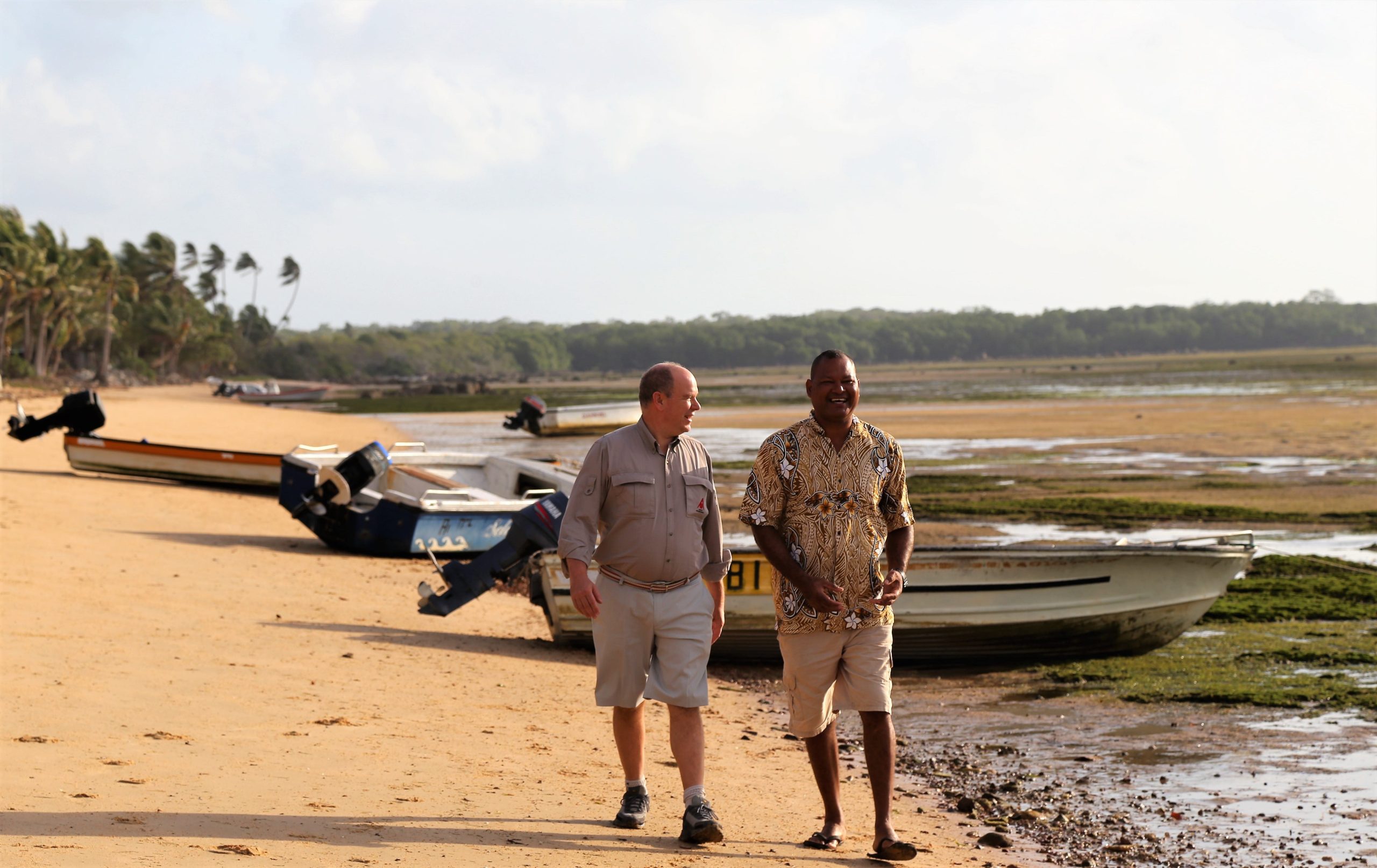Consider a message in a bottle.
There’s something romantic about a message in a bottle – written to communicate with a stranger in a far-off land, sealed with the hope of connection, and tossed into the ocean where the wills of the waves spirit it away on a journey that could last weeks, months, or decades. It inspires mystery, intrigue, and the hope of connection with a far-off stranger sometime in the future.
Romanticism is wrapped up in the message itself, and it is less about the act of littering that comes with tossing a bottle into the ocean. When we do this, we consider that the bottle will eventually become someone else’s problem, someone else’s object to deal with, and as such, the message becomes a polite way of saying “Hello, here is a bottle you may now discard, I would like to meet you one day.”
In Douglas Watkin’s wonderful documentary Alick and Albert, the ‘message in a bottle’ is Alick Tipoti’s artwork. Alick is a man who lives on the island of Badu in the Torres Strait utilising his artwork to tell the story of his culture, of the people of the islands he lives on, and the marine life that provide a connection to land and spirituality. When Alick visits Monaco to display his artwork, a powerful friendship is forged across the oceans with Prince Albert II from Monaco. At L’Institut Océanographique de Monaco where Alick’s art is displayed, Alick gives an off-handed invitation to Albert to come and visit Badu. Alick doesn’t truly believe that Albert would take him up on the offer, but sure enough with a chartered plane Albert visits Badu to see how the culture of the Torres Strait people lives and to also witness first-hand the impact of climate change on these small islands.
Thematic multitudes exist within Alick and Albert, paired with stunning visual imagery of the islands the dugongs and turtles that call the ocean home and of Monaco’s grand architecture. Each shot reinforces the notion that art equals cultural preservation, an ethos and mindset that would be best kept in the front of the mind of many Aussie filmmakers.
“To be a good hunter, there needs to be a strong connection with the hunted.” While Alick is referring to the dugongs here, the multitudes in this statement carries recognition of Luis vas des Torres travels through the strait in 1606, the impact of colonisation, and in turn, the impact of climate change and pollution on the islands. The ‘good hunter’ is the people of the Torres Strait, but also the pollution itself, arriving each dawn on the shores of Badu like an unwelcome visitor to be cleared away by the islanders. The turtles’ migration and breeding cycles are disrupted by rising sea temperatures, the dugongs aren’t migrating in the way they used to, and the main export for the Torres Strait – crayfish – is dwindling due to the impact of climate change on the reefs. Within Alick’s artwork, gloriously translated to animated sequences throughout the film (one can only dream and hope for a feature animated film done in this style, documenting the Torres Strait Islander way of life, culture, and history), we see the past, present, and future of the Torres Strait, from the arrival of Luis vas des Torres, to the bond with the dugongs, and the impact of the rising tides.
While politicians in Canberra joke about the rising waters lapping at the doorstep of Pacific Islanders, the reality for the Badugal council of Badu is that they need to start considering a plan for the Islanders as the impacts of climate change come to their home. On Badu, while most of the village is on a higher ground, significant areas like the cemetery and the village waterfront areas are at risk of succumbing to rising tides and destructive storms. For neighbouring lower lying islands in the Torres Strait evacuation plans are being put in place as the reality of these islands disappearing completely is arriving sooner than expected.
Albert’s journey to Badu is initially to experience the Torres Strait lifestyle, to see where Alick gleans his artistic sight from, but he soon realises that his presence and support can be felt further than a royal visit. For Albert the message in a bottle is shown with the countless bottles and plastics scooped up by locals. But, unlike the hopeful discarder, eager for contact, the people (you, me, everybody we know) who discard these plastic bottles do so with the belief that they will be recycled in the future. The truth is quite different.
The spirit of Alick and Albert’s friendship thrives in the direction by Douglas Watkin which is light, and comforting. It gives space to the problems that the Torres Strait islander people face on a day-to-day basis but does so in a manner that is never leaden or exhausting. Instead, with a script by Douglas, Alick, and Trish Lake, Alick and Albert reminds audiences of the importance of culture and community. A pointed emotional moment has the women of Badu meeting Prince Albert and letting him know about their history of watching his mother, Grace Kelly, on screen in a segregated cinema on Thursday Island. Through the magic of film a foreign culture was introduced to the Torres Strait paralleling how Alick’s artwork has traversed the seas to be introduced as its own ‘foreign’ culture to Monaco. Equally, Alick and Albert works in harmony with many recent Australian documentaries like Maya Newell’s collaborative In My Blood it Runs (2019), Aaron Petersen’s Zach’s Ceremony (2016), and even Fist of Fury Noongar Daa (2021), where the reminder that the preservation of language, and the education of Indigenous languages, means a continuation and support for the Indigenous people of Australia.
Language and art keep culture alive in a tangible way, and as such keeps the practices and processes of life alive too. Echoes of the Tim Cole’s glorious documentary, Small Island, Big Song (2020), carry through here where the migration patterns of the Pacific Islanders helped bridge communities and share resources. It’s here where science meets culture, and Alick informs Albert about the Aboriginal and Torres Strait Islander people being the original scientists (as an aside: a welcome shout out to Corey Tutt’s excellent family friendly book, The First Scientists, also released in 2021, needs to be mentioned here, a vital addition to every growing kid’s library). Through a bond, Albert brings the Oceanographic society to the Torres Strait, working in unison with Australia to research the impact of climate change.
A grand and cruel irony is how the Liberal-lead Australian government throughout the years has put their focus solely on the growing economy, favouring mining companies over other industries, in turn leaving local industries like the crayfish divers of the Torres Strait in jeopardy as their livelihood is threatened by the growing impact of the warming waters around the globe. This quiet condemnation is presented here less as a fist-shake to consecutive conservative governments, and more as a dour recognition that this is the worsening future that faces the world as a whole.
At its close, Alick and Albert reminds us that the bonds that we foster along our journeys come from unexpected places. Through Alick’s art, he has created a modern ‘message in a bottle’ – a way of understanding our world in a wholistic manner through the emotions that it conjures within us. Instead of a wishful throw into the ocean, Alick instead has launched his artistic net far and wide, embracing the world as a whole in a call to recognise the Torres Strait and the plight of the Badugal people who call the region home.
Director: Douglas Watkin
Featuring: Alick Tipoti, Prince Albert of Monaco
Writers: Trish Lake, Alick Tipoti, Douglas Watkin



